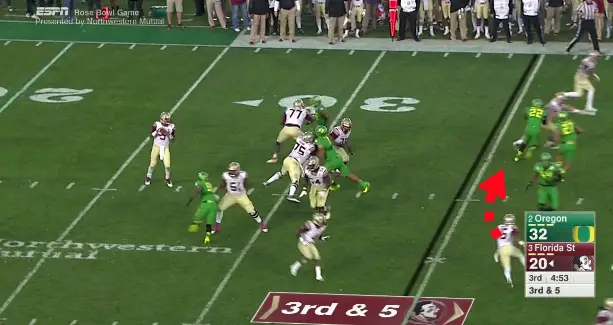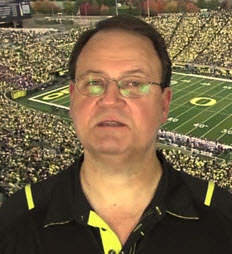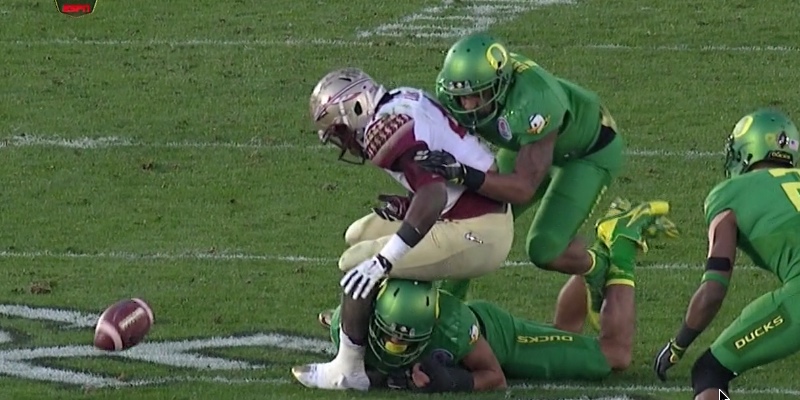You have heard the comments in the stands; heck, you may have even said it yourself!
“I hate Oregon’s bend-but-don’t-break defense. I hate how we only rush three, and we give up third-and-long way too often!”
Many people say that without understanding the reasoning behind utilizing the bend-but-don’t-break defense, and how it complements the Oregon offense. Let’s take a closer look at this defensive strategy against Florida State in the 2015 Rose Bowl through the eyes of FishDuck.com’s new defensive consultant, former Oregon safety Ryan Mitchell.
Defensive coordinator Don Pellum’s defense is based on the premise of observing early in the game how the opposing offense is attacking you, and adjusting from there. Against Florida State, we started out in a defense meant to take away what the Seminoles liked to do. Like Oregon, FSU loves big plays and wants to go over the top with long passes. Thus, we began in a Cover 2 defense with the safeties positioned deep to prevent the explosive play.

Look at the space between linebackers and safeties!
When we play a Cover 2 (shown above) the corners have the short zones near the boundaries, and when the FSU receiver goes deep — he is passed off to one of the two safeties. Look at the huge gap between the safeties (yellow arrows) preventing the deep pass, and the linebackers (green arrow).

A weakness of the Cover 2 …
What you see in the GIF above is a weakness of the Cover 2, which is the middle of the field. Coach Mitchell explained how Florida State exploited it well a number of times in the first half, and in particular executed those passes just behind the linebackers and in front of the safeties to take advantage of that gap discussed above.
At halftime, Coach Pellum made an adjustment that Ryan noted was simple, but effective: he had the linebackers take a deeper pass drop. This took away the middle routes and kept the intermediate routes in front of the coverage. Indeed, the basis of the bend-but-don’t-break strategy is to make the offense work hard for every yard by forcing it to execute well play after play all the way down the field.
The Seminoles had the deep pass taken away by the safeties, and the middle routes were removed by Pellum’s adjustment. Further, Oregon knew the Noles’ running game was not going to generate points fast enough to keep pace with the Ducks. Does this sound familiar (this is a very high-percentage defense for Oregon to run considering the offense in Eugene)?

The linebackers are dropping deeper …
The beginning of the play above had the Oregon defense threatening a six-man blitz, but three linebackers dropped off the line of scrimmage and ran back to their deep zones (this rush is what I call the Three-Duck-Chuck). Note how the only pass open for Florida State is a short pass to the running back cutting in front of the linebackers (red dotted arrow above).

Great defense!
Now the Oregon defense (above) begins to feast! With the explosion plays negated by keeping everything in front of them, the Ducks can attack downhill to the young FSU running back with ball-control issues. This turnover was a turning point in the game as the Ducks scored two plays later and the rout was on!

Point-Counterpoint.
But is there something the Oregon defense implements to counter the short check-downs to running backs, which can still eat up eight yards at a time? Absolutely. Note above how the FSU tight end (red dotted line) is pulling the linebacker over to cover him and opening up that zone for the running back (white dotted line above).
Whoa! The Ducks are running a Zone Blitz and dropping the Nose Tackle back into coverage (yellow line above of Alex Balducci)!

The Oregon Nose Tackle spoils the route …
Above we see how No. 86, Torrodney Prevot, has beaten the massive Florida State offensive tackle and is closing in on a sack. Normally the pass would be thrown before Prevot arrives, but at the moment Winston wants to throw the ball — Balducci steps into the route of the FSU tailback and prevents the throw (red dotted line/arrow above)!

A Zone Blitz will stop that!
This is a great example of how a great defensive call (the Zone Blitz) prevented a first down and almost created a turnover.
Can you run this defensive play each time on second- or third-and-long? No, as the opposing offense will pull a play out to thwart the Zone Blitz. The takeaway concept is how Oregon has defensive countermeasures to offset how the opponent is attacking the Ducks. A good defensive coordinator will make adjustments implementing those countermeasures, as Pellum did. Clearly it was an unsung factor that helped decide the Rose Bowl.
At times we all get frustrated when Oregon morphs into the Three-Duck-Chuck pass rush and drops eight defenders into zone coverage; while the opponent does convert on occasion, the stats show that the vast majority of the time they do not. When you learn that more than 75% of drives starting on the opponent’s 25-yard line do not end in points, it becomes apparent how hard it is for an offense to drive the length of the field on the Oregon defense.

Ryan Mitchell
The Ducks defense has forced 25 turnovers or more in a season for seven years in a row — far more than any team in college football! During this streak Oregon has been the No. 1 defense in the nation for holding down the number of explosion play touchdowns against them (explosion plays being defined as touchdowns of at least 40 yards). As such, the stats support the strategy used by the defensive brain trust in Eugene.
Turnovers and missed third-down conversions are the usual result, and thus the bend-but-don’t-break defense begins to make more sense. Preventing explosion plays, keeping plays in front of you and making the opposition dink and dunk all the way down the field is the hallmark of the Oregon defense.
Defensive consultant Ryan Mitchell will be helping the analysis staff at FishDuck.com, as well as creating some articles himself. You may recall how he almost got impaled 15 years ago during a game at Autzen with the drums and cymbals on the sidelines? Life in the tech industry is certainly a lot safer for him now, and we appreciate his contributions to this and future analyses.
The take home point for this analysis is that the Ducks score quickly, while making the opponent scratch their way down the field in a low-percentage endeavor. This is a superb formula for creating pressure on the opponent, which leads them to take more chances, which results in more turnovers for the opportunistic Oregon defense.
Regardless of our opinions on the defensive philosophy at Oregon, it is quite apparent that it works.
“Oh how we love to learn about our Beloved Ducks!”
Charles Fischer (FishDuck)
Oregon Football Analyst for CFF Network/FishDuck.com
Eugene, Oregon
Top Photo from Video

Charles Fischer has been an intense fan of the Ducks, a season ticket holder at Autzen Stadium for 35 years and has written reports on football boards for over 23 years. Known as “FishDuck” on those boards, he is acknowledged for providing intense detail in his scrimmage reports and in his Xs and Os play analyses. He and his wife Lois, have a daughter Christine, reside in Eugene Oregon, where he was a Financial Advisor for 36 years and now focuses full-time on Charitable Planned Giving Workshops for churches and non-profit organizations.
He does not profess to be a coach or analyst, but simply a “hack” that enjoys sharing what he has learned and invites others to correct or add to this body of Oregon Football! See More…


